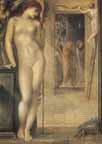
In concert with many other Pre-Raphaelite works, Burne-Jones's Venus Epithalamia tells a story of tragic love. In Greek mythology, Venus marries Vulcan, but is passionately in love with Mars. Burne-Jones depicts Venus hiding behind the doorway just inside the first of three chambers in the painting. She looks down, her milky and marble-like body in a contrapposto stance. Venus leans on a small table to her right, where in the shadows, hidden is a small, masked cupid. In the next room another nude seems to gleefully hang a garland while perched on a ladder, his back to the viewer. The energized position of his body with one foot suspended in balance and motion acts as a strong contrast to the sedate, melancholy position of Venus in the foreground. Venus's face and body, except her lower legs, are cast in shadow, whereas a strong light source can be seen coming from a window and illuminating the next room. Though the strong light in the center room indicates daylight, torches burn in the far chamber, as well as behind Venus in the foreground. In the background a line of fair maidens process down a staircase and past the doorway, paying no head to what's happening in the front two rooms. The procession of women echoes another Burne-Jones work, The Golden Staircase.
Burne-Jones used his lover Maria Zambaco as his model for Venus. Interestingly, her relationship with the artist mimics the myth portrayed in the painting. Like Venus, Zambaco was inharmoniously married to someone else when she fell in love with Burne-Jones (Peter Nahum VW). Venus (or Maria) communicates a feeling of longing and sadness in her body language and facial expression. The title of the work refers to a wedding song, usually sung to the bride and bridegroom in the doorway as they enter their chamber. In the case of Venus and of Maria Zambaco, the wedding day was not a happy affair. The tragedy of these two women lies in their attachment through the wedding ceremony and the ritual utterance of the epithalamia (wedding song) while their true hearts belong to Mars and Burne-Jones, respectively.
Questions
1. Unlike other Burne-Jones works, Venus Epithalamia conveys some degree of spatial depth. Burne-Jones creates this depth by using three distinctive visual fields with Venus defining the foreground, the figure on the ladder occupying the middle, and the procession of women filling the background. Why does Burne-Jones leave open space in the middle ground and choose to crowd the background? What effect does the contrast between crowded and empty space have on the overall composition and mood of the work?
2. The way Burne-Jones composes the scene with Venus and the other nude grabbing the viewer's attention before the women in the background are even noticed sets up a dramatic irony. The viewer sees Venus and the other nude figure, but it seems that the figures in the background aren't aware of their presence. Instead, the maidens stream past the doorway, scarcely even looking through the open door that they pass. Where are the maidens going and why do they ignore the two nude figures?
3. It is significant to note that Venus and the other figure are nude, whereas the women in the final chamber are all clothed. What significance does Burne-Jones's choice to leave the two most significant figures in the work nude have?
4. Burne-Jones includes many possible symbols in Venus Epithalamia. What possible meaning could the masked cupid, the garlands hung around the doorway, the scroll and greenery in the bottom right, and the torches have?
5. Burne-Jones's treatment of interior space in Venus Epithalamia is integral to the meaning of the work. What other Pre-Raphaelite works instill such significance in the interior? How does the way Burne-Jones depicts the three rooms reflect Venus's situation ?
Bibliography
Study Guide on Epithalamia: http://people.whitman.edu/~dipasatm/epith.htm
Last modified 29 October 2004